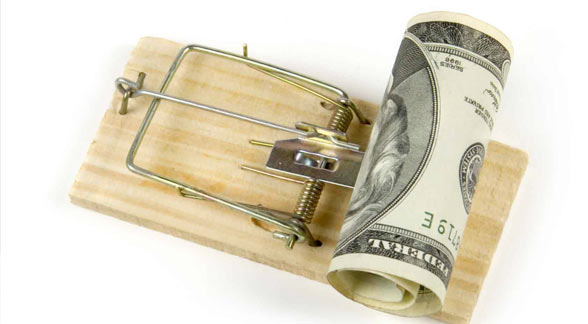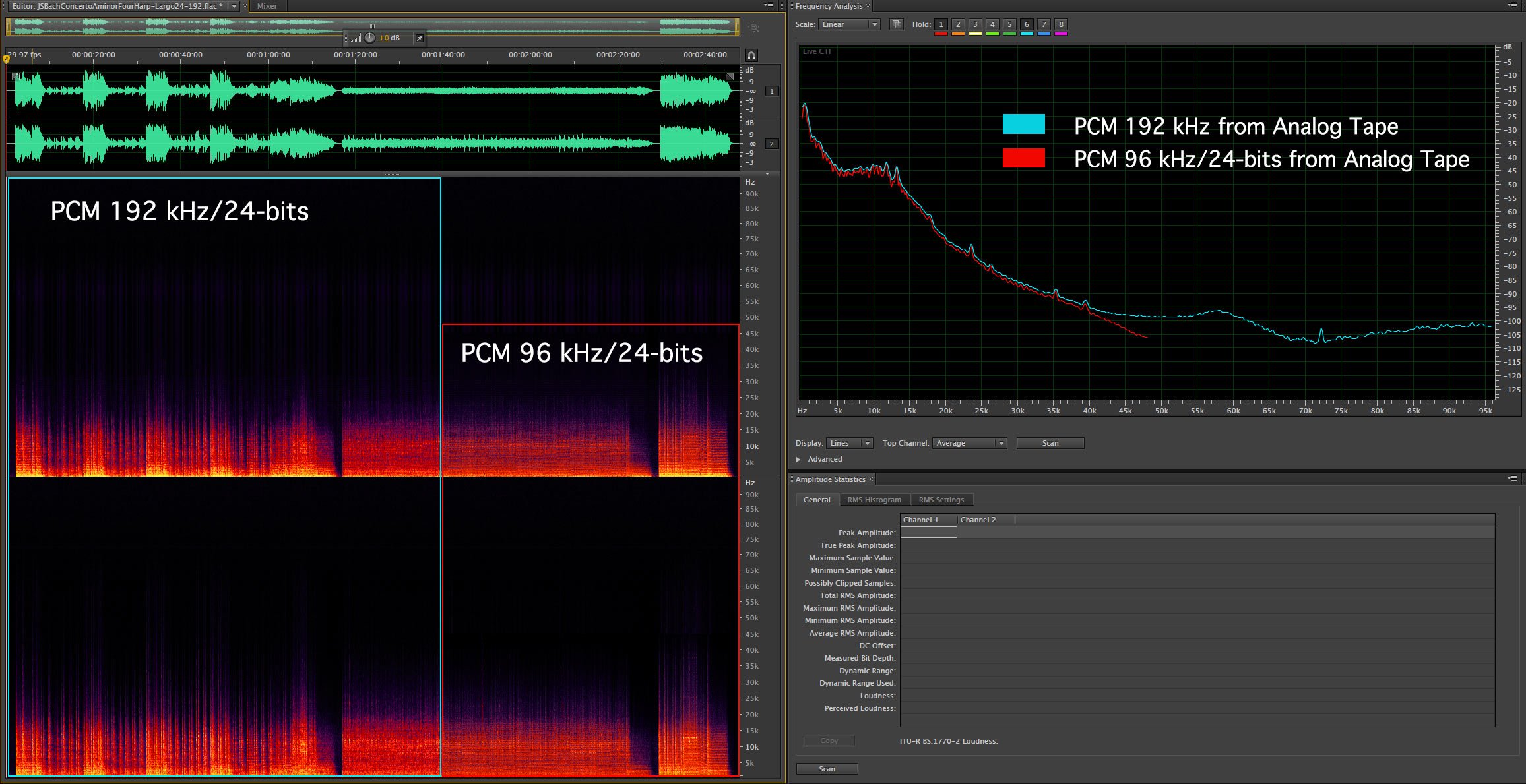Tape Transfers to HD?
Yesterday, I wrote about David Robinson’s affection for HDTT (High Definition Tape Transfers) DSD 128 digital files. The company acquires non-copyrighted consumer analog tapes and then makes very good digital copies of them to both PCM and now DSD. They used to feature HD-PCM files at 192 and 96 kHz sample rates but have recently added DSD 64 and DSD 128 versions to their offerings. The files can be downloaded or purchased on data discs.
Having spent a great deal of my professional life working with analog tape (both multitrack AND stereo), I was curious whether HDTT had any free samples to check out. They have a number of items on their site and I downloaded the Largo movement from J. S. Bach’s Concerto in A minor at both 96 and 192 kHz 24-bit PCM.
There wasn’t any information on the site regarding the speed and format of the original master tape. It could have been half track stereo or even quarter track stereo (although I doubt it) at 3 3/4 or 7 1/2 ips…maybe 15 ips. There weren’t a lot of 15 ips machines around back in the 60s. I know my own Wollensak unit was limited to the lower pair of speeds. This would mean that the highest reasonable frequencies that I would expect to see or hear on these transferred files would be around 20-25 kHz.
The dynamic range of a consumer tape from 50 years ago would also be less than ideal. Without Dolby noise reduction, one might expect to have 60-65 dB or dynamic range on the original master. Subsequent copies, however, would be reduced by 6 dB at each analog transfer stage. The normal process for an analog tape would be: record the original master and then edit it after making a safety copy, copy the edited original through mastering (the first transfer stage) and then make a dub master (second copy and another 6 dB lost) from which customer copies are made (third copy stage). The best we can hope for is that a terrific master analog tape was made and we get a digital transfer that has 18 dB more noise than the original (as a result of the three generations of transfers. Remember that this is equivalent to about 8-bits of dynamic range in PCM digital…not matter what size the digital words used during the transfers.
At the end of this process we have a sound that David Robinson of Positive Feedback Online said, “…moved me to my soul”.
I listened to the Bach sample in my state-of-the-art studio (using a Benchmark DAC2, Bryston 4B power and B&W 801 Series III speakers and I experienced something considerably less moving. The lack of dynamic range was the first thing that I noticed. The sound was nice enough although to my ears distant, detached and flat sounding with very little depth and timbral accuracy (the low end was thin). I would suggest that you download the AIX Records Bach Brandenburg demo recording that I placed on my FTP site (which can be acquired for evaluation without charge) and then download the Bach from HDTT. Compare them and let me know what you think. Which, if any, moves YOUR soul?
Figure 1 – Spectragraph of an HDTT download of a Bach Concerto movement. Click to enlarge.
So here’s the spectragraph. You’ll notice that the 192 and 96 kHz versions are identical up to 40 kHz. After that the 192 version is devoid of any musical material and contributes nothing to the overall sound. The measured dynamic range is about 50 dB or well within 9-bits of PCM equivalent (just past the dynamic range in the 8-bit games we used to play with our Creative Labs Sound Blaster PC sound cards). For comparison, the AIX Bach recording topped out at 97 dB or 17 bits! I can understand the attraction if a performance was historically important or by a prominent conductor but as a model of what we should be striving for sonically…I don’t get it. There’s got to be extra musical reasons behind a reviewer lauding a track that pales in comparison to a contemporary HD-Audio recording. And I haven’t even started talking about a 5.1 surround mix!
Take a listen and please let me know what YOU think.



I would be curious to understand how you get a measured dynamic range of 50 dB from the shown spectragraph. On the spectrum plot at the up right corner of the spectragraph, we can see a amplitude range between -20 dB for low frequencies down to -110 dB above 50kHz, implying a dynamic range around 90 dB.
Also you mention that 18 dB of additional noise is equivalent to about 8-bits of dynamic range in PCM. Given the fact that 1 bit is equivalent to 6 dB of dynamic range (20*log(2) = 6 dB), then 18 dB should be equivalent to 3 bits (20*log(8)= 18 dB and 8 = 2^3). What do you think ?
Thanks for the comment. to your questions…I use Adobe Audition to determine the dynamic range of a given selection or portion of a selection. In the case of the HDTT piece, I selected the entire recording and did the dynamic analysis…the results came in a about 50 dB, which is in keeping with what I would expect from an analog tape copied several times from the original source.
The 18 dB of reduced dynamic range is arrived at by taking the 6 dB reduction due to a generation loss and multiplying it by the three transfers. Each 6 dB is equal to 1-bit in PCM terms. If I start with the max possible dynamic range of 60ish and subtract 18, I get 48 dB. Divide 48 by 6 to get the number of bits. I added a bit because the number was actually 50 dB. That’s how I got 9-bits.
Mark,
I realise that it has been quite a while since I promised you to give the samples a proper listen and post my impressions here. My apologies for the long wait.
I just listened to both Bach samples you suggested on my Astell & Kern AK100 with a set of Beyerdynamic T70p headphones which I selected after listening to a whole range of headphones on the High End Audio Show in Munich this year (if you ever decide to take your activities regarding audio shows overseas, please give this one a consideration).
Please also excuse if some of the wording in my review below is not very scientific, it’s just a layman’s attempt to put into words what I hear.
I first listened to your recording in 96/24. I found it to be crips and clear, I can clearly distinguish all instruments when I concentrate on a specific one. The sound of instruments is well-rounded and pleasing to my ears. Also, I could not hear any noise at all. It simply sounded wonderful to me.
Next came the download from HDTT. I chose the 192/24 file for this (maybe a bit unfair, but you keep telling us that it will not make a difference anyway ;-))
The first thing that I noticed even before the musicians started playing was the noise in the silent part of the track along with some crackling. Then the orchestra comes in – which sounded very harsh to me. At this point I was tempted to reduce the volume. I can’t really judge if this is to be attributed to the recording techniques or to the medium it was recorded to, but I found that in comparison to your recording the sound of the instruments is very harsh and edgy. Maybe this is how the instruments sounded when this was recorded, but to me it didn’t make for a very joyful listening experience. I had also trouble distinguishing the different instruments when the orchestra played. They kind of blurred together (they are supposed to blend together, but not blur together, IMHO).
Also, I found that there were some other problems with the occasional crakling noise. If I have to listen to this for the whole concert I would have definitely needed to use a lower level than with your recording.
So here you go. I don’t think I will be buying downloads from HDTT anytime soon, unless they have a recording of an artist or a specific piece I really want that I can’t get in better quality.
Best regards,
Oliver
Oliver, thanks for the considered and thoughtful comment.